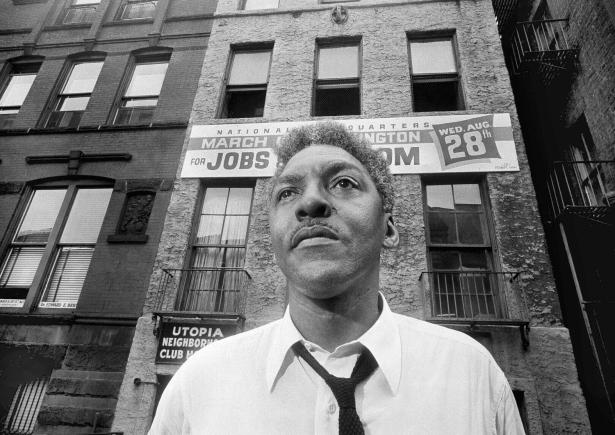You have probably noticed the buzz about the new biopic about one of America’s greatest and most often overlooked civil rights leaders, Bayard Rustin. Maybe you’ve already watched it.
As biopics go, this one is so-so. It gets the basic details of Rustin’s story right, and the acting is decent. But nobody other than Martin Luther King should ever try to play Martin Luther King. (Maybe it can work with J. Robert Oppenheimer or Leonard Bernstein.) And no actor can equal the real Bayard Rustin.
Fortunately, there is a superb documentary about Rustin himself, the world he inhabited, and the difference he made. It’s perfectly titled Brother Outsider. The film was made in 2003 by California Newsreel, produced and directed by Nancy Kates and Bennett Singer, and deserves your attention. It’s a little hard to find to stream, but you can rent it on Vimeo for $2.99.
Rustin was born in 1912 in West Chester, Pennsylvania, the grandson of Quakers who raised him. He became a pacifist and a nonviolent agitator for social justice. One of his heroes was Gandhi. Like other Black radicals in the 1930s, he briefly joined the Communist Party, which was one of the very few institutions of that era that was serious about racial justice.
Rustin was also gay.
As a pacifist, he refused to be drafted in World War II and served two years in prison. After the war, he was well ahead of his time, getting arrested for trying to integrate a Southern bus in 1947, years before the Montgomery bus boycott of 1955 and the Freedom Rides of 1961. Arrested, he served 27 days on a North Carolina chain gang, and then managed to get chain gangs abolished in that state.
What Rustin did best was to organize. When Rustin met the very young Martin Luther King, who was thrust into leadership of nonviolent civil disobedience while still in his mid-twenties, the older man realized that Dr. King was wise beyond his years when it came to moral witness but knew almost nothing about the practicalities of organizing. Rustin, then in his mid-thirties, became King’s tutor.
All of this and a great deal more is brilliantly shown in the documentary, with amazing archival footage. The peak moment of Rustin’s career was the August 1963 March on Washington for Jobs and Freedom. His job was lead organizer of the march. More than anyone else, Rustin made it happen, from the transportation to the logistics to the negotiations with other civil rights leaders, police, and a nervous Kennedy White House.
While we now think of peaceful protest marches on Washington as just part of the political choreography, until 1963 nobody had ever pulled one off. Rustin’s hero and mentor, the great Black trade unionist A. Philip Randolph, had threatened such a march in 1941 for equal job opportunities, but relented when FDR agreed to integrate war production. Randolph, aging but still active in 1963, is depicted as thrilled that his march finally happened.
We see Rustin, at the podium, next to Dr. King, as Rustin so often stood beside leaders who got the limelight, but was not quite a civil rights celebrity in his own right. Why not? He was a terrific orator. His opening speech was a fine combination of motivating uplift and the details of strategy. It was followed by King’s iconic “I Have a Dream” speech.
If King was the prophetic dreamer, Rustin was the practical tactician, though no less idealistic. As Brother Outsider makes clear, he was often found standing a bit to the side, because he was both a former communist and gay. King and other civil rights leaders were courageous in defending Rustin and realizing his value, but he was not quite right as the face of the movement.
The documentary is superb at giving us a sense of Rustin the person, with interviews with family members, other leaders, and with two lovers, one from early in his life and one late. And we see Rustin at one of his last marches, for LGBTQ rights.
After 1963, Rustin became the head of an institute named for A. Philip Randolph and financed by the AFL-CIO. As much as any Black leader, Rustin appreciated the importance of strengthening the coalition between civil rights and labor. It was Rustin, tragically, who pressed Dr. King to go to Memphis in 1968 in support of striking sanitation workers.
And in an era of Black Power, Rustin never ceased being a passionate integrationist. The film shows fascinating rare footage of Rustin in debate with Malcolm X and with Stokely Carmichael.
It’s a history we all should know, in detail, and too important to leave to the fancies and fantasies of biopics. It’s good that the movie, Rustin, has rekindled interest in his career. But the documentary is the one to see.
Robert Kuttner is co-founder and co-editor of The American Prospect, and professor at Brandeis University’s Heller School. His latest book is Going Big: FDR’s Legacy, Biden’s New Deal, and the Struggle to Save Democracy.
Read the original article at Prospect.org.
Used with the permission. © The American Prospect, Prospect.org, 2023. All rights reserved.
Click here to support the Prospect's brand of independent impact journalism.


Spread the word